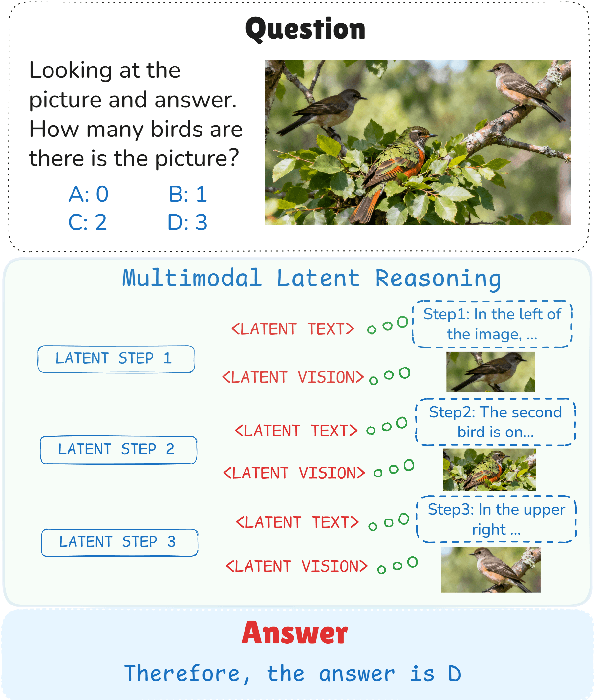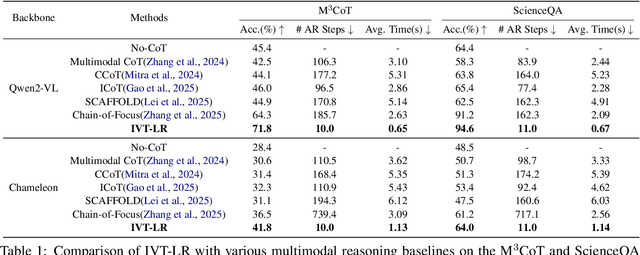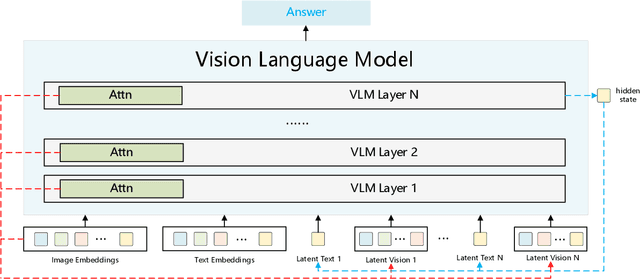Yongqi Li
Reasoning in the Dark: Interleaved Vision-Text Reasoning in Latent Space
Oct 14, 2025



Abstract:Multimodal reasoning aims to enhance the capabilities of MLLMs by incorporating intermediate reasoning steps before reaching the final answer. It has evolved from text-only reasoning to the integration of visual information, enabling the thought process to be conveyed through both images and text. Despite its effectiveness, current multimodal reasoning methods depend on explicit reasoning steps that require labor-intensive vision-text annotations and inherently introduce significant inference latency. To address these issues, we introduce multimodal latent reasoning with the advantages of multimodal representation, reduced annotation, and inference efficiency. To facilicate it, we propose Interleaved Vision-Text Latent Reasoning (IVT-LR), which injects both visual and textual information in the reasoning process within the latent space. Specifically, IVT-LR represents each reasoning step by combining two implicit parts: latent text (the hidden states from the previous step) and latent vision (a set of selected image embeddings). We further introduce a progressive multi-stage training strategy to enable MLLMs to perform the above multimodal latent reasoning steps. Experiments on M3CoT and ScienceQA demonstrate that our IVT-LR method achieves an average performance increase of 5.45% in accuracy, while simultaneously achieving a speed increase of over 5 times compared to existing approaches. Code available at https://github.com/FYYDCC/IVT-LR.
Parallel Test-Time Scaling for Latent Reasoning Models
Oct 09, 2025Abstract:Parallel test-time scaling (TTS) is a pivotal approach for enhancing large language models (LLMs), typically by sampling multiple token-based chains-of-thought in parallel and aggregating outcomes through voting or search. Recent advances in latent reasoning, where intermediate reasoning unfolds in continuous vector spaces, offer a more efficient alternative to explicit Chain-of-Thought, yet whether such latent models can similarly benefit from parallel TTS remains open, mainly due to the absence of sampling mechanisms in continuous space, and the lack of probabilistic signals for advanced trajectory aggregation. \ This work enables parallel TTS for latent reasoning models by addressing the above issues. For sampling, we introduce two uncertainty-inspired stochastic strategies: Monte Carlo Dropout and Additive Gaussian Noise. For aggregation, we design a Latent Reward Model (LatentRM) trained with step-wise contrastive objective to score and guide latent reasoning. Extensive experiments and visualization analyses show that both sampling strategies scale effectively with compute and exhibit distinct exploration dynamics, while LatentRM enables effective trajectory selection. Together, our explorations open a new direction for scalable inference in continuous spaces. Code released at https://github.com/YRYangang/LatentTTS.
A Survey on Training-free Alignment of Large Language Models
Aug 12, 2025Abstract:The alignment of large language models (LLMs) aims to ensure their outputs adhere to human values, ethical standards, and legal norms. Traditional alignment methods often rely on resource-intensive fine-tuning (FT), which may suffer from knowledge degradation and face challenges in scenarios where the model accessibility or computational resources are constrained. In contrast, training-free (TF) alignment techniques--leveraging in-context learning, decoding-time adjustments, and post-generation corrections--offer a promising alternative by enabling alignment without heavily retraining LLMs, making them adaptable to both open-source and closed-source environments. This paper presents the first systematic review of TF alignment methods, categorizing them by stages of pre-decoding, in-decoding, and post-decoding. For each stage, we provide a detailed examination from the viewpoint of LLMs and multimodal LLMs (MLLMs), highlighting their mechanisms and limitations. Furthermore, we identify key challenges and future directions, paving the way for more inclusive and effective TF alignment techniques. By synthesizing and organizing the rapidly growing body of research, this survey offers a guidance for practitioners and advances the development of safer and more reliable LLMs.
Scaling over Scaling: Exploring Test-Time Scaling Pareto in Large Reasoning Models
May 26, 2025Abstract:Large reasoning models (LRMs) have exhibited the capacity of enhancing reasoning performance via internal test-time scaling. Building upon this, a promising direction is to further scale test-time compute to unlock even greater reasoning capabilities. However, as we push these scaling boundaries, systematically understanding the practical limits and achieving optimal resource allocation becomes a critical challenge. In this paper, we investigate the scaling Pareto of test-time scaling and introduce the Test-Time Scaling Performance Model (TTSPM). We theoretically analyze two fundamental paradigms for such extended scaling, parallel scaling and sequential scaling, from a probabilistic modeling perspective. Our primary contribution is the derivation of the saturation point on the scaling budget for both strategies, identifying thresholds beyond which additional computation yields diminishing returns. Remarkably, despite their distinct mechanisms, both paradigms converge to a unified mathematical structure in their upper bounds. We empirically validate our theoretical findings on challenging reasoning benchmarks, including AIME, MATH-500, and GPQA, demonstrating the practical utility of these bounds for test-time resource allocation. We hope that this work provides insights into the cost-benefit trade-offs of test-time scaling, guiding the development of more resource-efficient inference strategies for large reasoning models.
$\text{R}^2\text{ec}$: Towards Large Recommender Models with Reasoning
May 22, 2025Abstract:Large recommender models have extended LLMs as powerful recommenders via encoding or item generation, and recent breakthroughs in LLM reasoning synchronously motivate the exploration of reasoning in recommendation. Current studies usually position LLMs as external reasoning modules to yield auxiliary thought for augmenting conventional recommendation pipelines. However, such decoupled designs are limited in significant resource cost and suboptimal joint optimization. To address these issues, we propose \name, a unified large recommender model with intrinsic reasoning capabilities. Initially, we reconceptualize the model architecture to facilitate interleaved reasoning and recommendation in the autoregressive process. Subsequently, we propose RecPO, a corresponding reinforcement learning framework that optimizes \name\ both the reasoning and recommendation capabilities simultaneously in a single policy update; RecPO introduces a fused reward scheme that solely leverages recommendation labels to simulate the reasoning capability, eliminating dependency on specialized reasoning annotations. Experiments on three datasets with various baselines verify the effectiveness of \name, showing relative improvements of 68.67\% in Hit@5 and 45.21\% in NDCG@20. Code available at https://github.com/YRYangang/RRec.
Exploring Training and Inference Scaling Laws in Generative Retrieval
Mar 24, 2025Abstract:Generative retrieval has emerged as a novel paradigm that leverages large language models (LLMs) to autoregressively generate document identifiers. Although promising, the mechanisms that underpin its performance and scalability remain largely unclear. We conduct a systematic investigation of training and inference scaling laws in generative retrieval, exploring how model size, training data scale, and inference-time compute jointly influence retrieval performance. To address the lack of suitable metrics, we propose a novel evaluation measure inspired by contrastive entropy and generation loss, providing a continuous performance signal that enables robust comparisons across diverse generative retrieval methods. Our experiments show that n-gram-based methods demonstrate strong alignment with both training and inference scaling laws, especially when paired with larger LLMs. Furthermore, increasing inference computation yields substantial performance gains, revealing that generative retrieval can significantly benefit from higher compute budgets at inference. Across these settings, LLaMA models consistently outperform T5 models, suggesting a particular advantage for larger decoder-only models in generative retrieval. Taken together, our findings underscore that model sizes, data availability, and inference computation interact to unlock the full potential of generative retrieval, offering new insights for designing and optimizing future systems.
Towards Harmless Multimodal Assistants with Blind Preference Optimization
Mar 18, 2025Abstract:Multimodal Large Language Models (MLLMs) have demonstrated impressive capabilities in multimodal understanding, reasoning, and interaction. Given the extensive applications of MLLMs, the associated safety issues have become increasingly critical. Due to the effectiveness of preference optimization in aligning MLLMs with human preferences, there is an urgent need for safety-related preference data for MLLMs. To address this, we construct the MMSafe-PO preference dataset towards harmless multimodal assistants, featuring multimodal instructions, the conversational format, and ranked paired responses from human feedback. We also identify two insightful observations: modality co-defense and modality cheating, which illustrate that MLLMs possess a certain level of inherent defense while still presenting unique safety challenges. Based on these observations, we propose the Blind Preference Optimization (BPO) approach. Comprehensive experiments on three benchmarks show that BPO effectively enhances the safety capabilities of MLLMs. Notably, BPO significantly improves the safety rate of the base MLLM by 45.0%, outperforming the DPO approach. Additionally, applying BPO to the MMSafe-PO dataset greatly reduces the base MLLM's unsafe rate on other safety benchmarks (14.5% on MM-SafetyBench and 82.9% on HarmEval, demonstrating the effectiveness and robustness of both the dataset and the approach. We release code and data at https://lu-yang666.github.io/MMsafe-PO-Web/.
Adaptive Moment Estimation Optimization Algorithm Using Projection Gradient for Deep Learning
Mar 13, 2025Abstract:Training deep neural networks is challenging. To accelerate training and enhance performance, we propose PadamP, a novel optimization algorithm. PadamP is derived by applying the adaptive estimation of the p-th power of the second-order moments under scale invariance, enhancing projection adaptability by modifying the projection discrimination condition. It is integrated into Adam-type algorithms, accelerating training, boosting performance, and improving generalization in deep learning. Combining projected gradient benefits with adaptive moment estimation, PadamP tackles unconstrained non-convex problems. Convergence for the non-convex case is analyzed, focusing on the decoupling of first-order moment estimation coefficients and second-order moment estimation coefficients. Unlike prior work relying on , our proof generalizes the convergence theorem, enhancing practicality. Experiments using VGG-16 and ResNet-18 on CIFAR-10 and CIFAR-100 show PadamP's effectiveness, with notable performance on CIFAR-10/100, especially for VGG-16. The results demonstrate that PadamP outperforms existing algorithms in terms of convergence speed and generalization ability, making it a valuable addition to the field of deep learning optimization.
MultiConIR: Towards multi-condition Information Retrieval
Mar 11, 2025



Abstract:In this paper, we introduce MultiConIR, the first benchmark designed to evaluate retrieval models in multi-condition scenarios. Unlike existing datasets that primarily focus on single-condition queries from search engines, MultiConIR captures real-world complexity by incorporating five diverse domains: books, movies, people, medical cases, and legal documents. We propose three tasks to systematically assess retrieval and reranking models on multi-condition robustness, monotonic relevance ranking, and query format sensitivity. Our findings reveal that existing retrieval and reranking models struggle with multi-condition retrieval, with rerankers suffering severe performance degradation as query complexity increases. We further investigate the performance gap between retrieval and reranking models, exploring potential reasons for these discrepancies, and analysis the impact of different pooling strategies on condition placement sensitivity. Finally, we highlight the strengths of GritLM and Nv-Embed, which demonstrate enhanced adaptability to multi-condition queries, offering insights for future retrieval models. The code and datasets are available at https://github.com/EIT-NLP/MultiConIR.
PEToolLLM: Towards Personalized Tool Learning in Large Language Models
Feb 26, 2025Abstract:Tool learning has emerged as a promising direction by extending Large Language Models' (LLMs) capabilities with external tools. Existing tool learning studies primarily focus on the general-purpose tool-use capability, which addresses explicit user requirements in instructions. However, they overlook the importance of personalized tool-use capability, leading to an inability to handle implicit user preferences. To address the limitation, we first formulate the task of personalized tool learning, which integrates user's interaction history towards personalized tool usage. To fill the gap of missing benchmarks, we construct PEToolBench, featuring diverse user preferences reflected in interaction history under three distinct personalized settings, and encompassing a wide range of tool-use scenarios. Moreover, we propose a framework PEToolLLaMA to adapt LLMs to the personalized tool learning task, which is trained through supervised fine-tuning and direct preference optimization. Extensive experiments on PEToolBench demonstrate the superiority of PEToolLLaMA over existing LLMs.
 Add to Chrome
Add to Chrome Add to Firefox
Add to Firefox Add to Edge
Add to Edge